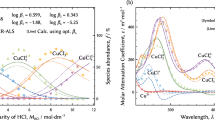Abstract
The determination of equilibrium constants is difficult when several chemical species are simultaneously present in solution. In this investigation, optical emission spectroscopic determinations of chromium(III) concentration in a 10−4 mol⋅dm−3 solution, prepared from K2Cr2O7 reduced in HNO3 or HCl media, were used to construct the pCr(aq)–pC H diagram. This diagram was used to calculate the pC H borderline of precipitation, to estimate the solubility product \((\log_{10}K_{\mathrm{sp,Cr(OH)}_{3}}^{*})\), and the hydrolysis constants \((\log_{10}\beta_{\mathrm{Cr,H}}^{*},\log_{10}\beta_{\mathrm{Cr,2H}}^{*}\), and \(\log_{10}\beta_{\mathrm{Cr,3H}}^{*})\) of Cr(III). The hydrolysis constants were also calculated using the SQUAD and SUPERQUAD software, along with the average ligand number method. UV-Vis absorption data and associated variables were used in SQUAD, SUPERQUAD, and the average ligand calculations. Results are: 9.00±0.04 for the pC H at the onset of precipitation, 12.40 for \(\log_{10}K_{\mathrm{sp,Cr(OH)}_{3}}^{*}\), −3.52±0.02 for \(\log_{10}\beta_{\mathrm{Cr,H}}^{*}\), −9.30±0.87 for \(\log_{10}\beta_{\mathrm{Cr,2H}}^{*}\) and −17.18±0.16 for \(\log_{10}\beta_{\mathrm{Cr,3H}}^{*}\), respectively. All methods produced essentially the same values for the hydrolysis constants of Cr(III).
Similar content being viewed by others
References
Zayed, A., Lytle, C.M., Jin-Hong, Q., Norman, T.: Chromium accumulation, translocation and chemical speciation in vegetable crops. Planta 206, 293–299 (1998)
Shan-Li, W., Chung-Chi, C., Yu-Min, T., Chia-Lian, H., Jen-Hshuan, C., Chen-Fang, L.: A mechanism study of light-induced Cr(VI) reduction in an acidic solution. J. Hazard. Mater. 164, 223–228 (2009)
Kotas, J., Stasicka, Z.: Chromium occurrence in the environment and methods of its speciation. Environ. Pollut. 107, 263–283 (2000)
Rai, D., Sass, B.M., Moore, D.A.: Chromium(III) hydrolysis constants and solubility of chromium(III) hydroxide. Inorg. Chem. 26, 345–349 (1987)
Pezzin, S.H., Rivera, J.F.L., Collins, C.H., Collins, K.E.J.: Reduction of trace quantities of chromium(VI) by strong acids. Braz. Chem. Soc. 15, 58–65 (2004)
Ringbom, A.: Complexation in Analytical Chemistry. Wiley, New York (1963)
Baes, Jr., C.F., Mesmer, R.E.: The Hydrolysis of Cations. Wiley, New York (1977)
Ramírez-García, J.J., Jiménez-Reyes, M., Solache-Ríos, M., Fernández-Ramírez, E., López-González, H., Rojas-Hernández, A.: Solubility and first hydrolysis constants of europium at different ionic strength and 303 K. J. Radioanal. Nucl. Chem. 257, 299–303 (2003)
Ramírez-García, J.J., Solache-Ríos, M., Jiménez-Reyes, M., Rojas-Hernández, A.: Solubility and hydrolysis of La, Pr, Eu, Er, and Lu in 1 M NaCl ionic strength at 303 K. J. Solution Chem. 32, 879–896 (2003)
López-González, H., Solache-Ríos, M., Jiménez-Reyes, M., Ramírez-García, J., Rojas- Hernández, A.: Effect of chloride ions on the hydrolysis of trivalent lanthanum, praseodymium, and lutetium in aqueous solutions of 2 M ionic strength. J. Solution Chem. 34, 427–441 (2005)
Jiménez-Reyes, M., Solache-Ríos, M., Rojas-Hernández, A.: Applications of the specific ion interaction theory to the solubility product and first hydrolysis constants of europium. J. Solution Chem. 35, 201–214 (2006)
López-González, H., Solache-Ríos, M., Jiménez-Reyes, M., Rojas-Hernández, A.: Solubility and hydrolysis of lutetium at different [Lu3+]initial. J. Radioanal. Nucl. Chem. 274, 103–108 (2007)
Ohata, M., Takaku, Y., Inagaki, K., Hioki, A., Chiba, K.: Improvement of analytical sensitivity by Ar-N2 inductively coupled plasma in axially viewing optical emission spectrometry. Anal. Sci. 25, 161–163 (2009)
Careri, M., Elviri, L., Mangia, A.: Element-tagged immunoassay with inductively coupled plasma mass spectrometry for multianalyte detection. Anal. Bioanal. Chem. 393, 57–61 (2009)
Legget, D.J., McBryde, W.A.E.: General computer program for the computation of stability constants from absorbance data. Anal. Chem. 47, 1065–1070 (1975)
Gans, P., Sabatini, A., Vacca, A.: SUPERQUAD: An improved general program for computation of formation constants from potentiometric data. J. Chem. Soc. Dalton Trans. 1195–1200 (1985)
Pinsuwan, S., Alvarez-Núñez, F.A., Tabibi, S.S., Yalkowsky, S.H.: Spectrophotometric determination of acidity constants of 4-dimethylamino sancycline (col-3), a new antitumor drug. J. Pharm. Sci. 88, 535–537 (1999)
Barrera-Diaz, C., Palomar-Pardave, M., Romero-Romo, M., Martinez, S.: Chemical and electrochemical consideration on the removal process of hexavalent chromium from aqueous media. J. Appl. Electrochem. 33, 61–71 (2003)
Philipot, J.M., Chaffange, F., Sibony, J.: Hexavalent chromium removal from drinking water. Water Sci. Technol. 17, 1121–1132 (1984)
Palmer, C.D., Windhausen, P.R.: Processes affecting the remediation of chromium-contaminated sites. Environ. Health Perspect. 92, 25–40 (1991)
Kumral, E.: Speciation of chromium in waters via sol-gel preconcentration prior to atomic spectrometric determination. Thesis of Master in Science, Engineering and Science of Izmir Institute of Technology, Izmir, Turkey (2007)
Fahim, N.F., Barsoum, B.N., Eid, A.E., Khalil, M.S.: Removal of chromium (III) from tannery wastewater using activated carbon from sugar industrial waste. J. Hazard. Mater. B 136, 303–309 (2006)
Author information
Authors and Affiliations
Corresponding author
Rights and permissions
About this article
Cite this article
Lopez-Gonzalez, H., Peralta-Videa, J.R., Romero-Guzman, E.T. et al. Determination of the Hydrolysis Constants and Solubility Product of Chromium(III) from Reduction of Dichromate Solutions by ICP-OES and UV–Visible Spectroscopy. J Solution Chem 39, 522–532 (2010). https://doi.org/10.1007/s10953-010-9522-0
Received:
Accepted:
Published:
Issue Date:
DOI: https://doi.org/10.1007/s10953-010-9522-0




